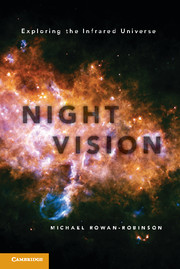Book contents
- Frontmatter
- Contents
- Preface
- 1 Introduction
- 2 William Herschel Opens Up the Invisible Universe
- 3 1800–1950
- 4 Dying Stars Shrouded in Dust and Stars Being Born
- 5 Birth of Submillimetre Astronomy
- 6 The Cosmic Microwave Background, Echo of the Big Bang
- 7 The Infrared Astronomical Satellite and the Opening Up of Extragalactic Infrared Astronomy
- 8 The Cosmic Background Explorer and the Ripples, the Wilkinson Microwave Anisotropy Probe and Dark Energy
- 9 Giant Ground-Based Near-Infrared and Submillimetre Telescopes
- 10 The Infrared Space Observatory and the Spitzer Space Telescope
- 11 Our Solar System’s Dusty Debris Disk and the Search for Exoplanets
- 12 The Future
- Epilogue
- Notes
- Credits for Illustrations
- Glossary
- Further Reading
- Bibliography
- Name Index
- Subject Index
12 - The Future
Pioneering Space Missions and Giant Ground-Based Telescopes
Published online by Cambridge University Press: 05 March 2013
- Frontmatter
- Contents
- Preface
- 1 Introduction
- 2 William Herschel Opens Up the Invisible Universe
- 3 1800–1950
- 4 Dying Stars Shrouded in Dust and Stars Being Born
- 5 Birth of Submillimetre Astronomy
- 6 The Cosmic Microwave Background, Echo of the Big Bang
- 7 The Infrared Astronomical Satellite and the Opening Up of Extragalactic Infrared Astronomy
- 8 The Cosmic Background Explorer and the Ripples, the Wilkinson Microwave Anisotropy Probe and Dark Energy
- 9 Giant Ground-Based Near-Infrared and Submillimetre Telescopes
- 10 The Infrared Space Observatory and the Spitzer Space Telescope
- 11 Our Solar System’s Dusty Debris Disk and the Search for Exoplanets
- 12 The Future
- Epilogue
- Notes
- Credits for Illustrations
- Glossary
- Further Reading
- Bibliography
- Name Index
- Subject Index
Summary
Finally, we look ahead to the next decade of infrared and submillimetre astronomy. This will be an era in which the infrared and submillimetre wavebands continue to have a dominant role, with spectacular space missions and giant, new ground-based facilities. I describe the three most recent infrared and submillimetre missions to be launched, Herschel, Planck, and WISE; the future planned missions, the James Webb Space Telescope and SPICA; and the future ground-based facilities, the Atacama Millimetre/Submillimetre Array and the very large 30–40-metre ground-based telescopes. We will see that the next decade will be just as exciting as the 25 years since the dramatic days of the IRAS mission have been.
Herschel and Planck: probing the cold universe
On 14 May 2009, the European Space Agency (ESA) launched together on top of a single Ariane 5 rocket two major space astronomy missions, the Herschel Space Observatory and Planck. The dual launch of these complex missions, at ESA’s space port at Kourou in French Guiana, was a great moment for European space science. It was an extremely moving moment for those of us who had worked on these missions since their inception. They were finally approved by ESA in 1993, Herschel (then known as FIRST, for Far InfraRed Space Telescope) as the fourth of ESA’s Horizon 2000 ‘cornerstone’ missions providing a multi-instrument observatory working at far-infrared and submillimetre wavelengths, and Planck (then known as Cobras-Samba) as a ‘medium’ mission to map the cosmic microwave background radiation. Cobras and Samba had been submitted as separate proposals, but ESA decided they should be merged into a single mission with two instruments, the Low Frequency Instrument (LFI), led by Reno Mandolesi and the High Frequency Instrument, led by Jean-Loup Puget. Both missions had been studied for many years before 1993.
- Type
- Chapter
- Information
- Night VisionExploring the Infrared Universe, pp. 168 - 184Publisher: Cambridge University PressPrint publication year: 2013



